
Complex counterpoint |
Complex counterpoint – a polyphonic combination of melodically developed voices (different or similar in imitation), which is designed for contrapuntal modified repetition, reproduction with a change in the ratio of these voices (as opposed to simple counterpoint – German einfacher Kontrapunkt – polyphonic combinations of voices used only in one given of their combinations).
Abroad, the term “S. to.” does not apply; in him. musicological literature uses the related concept mehrfacher Kontrapunkt, denoting only triple and quadruple vertically movable counterpoint. In S. to., the original (given, original) connection of melodic is distinguished. voices and one or more derivative compounds – polyphonic. original options. Depending on the nature of the changes, there are, according to the teachings of S. I. Taneyev, three main types of counterpoint: mobile counterpoint (divided into vertically mobile, horizontally mobile and doubly mobile), reversible counterpoint (divided into complete and incomplete reversible ) and counterpoint, which allows doubling (one of the varieties of mobile counterpoint). All these types of S. to. are often combined; for example, in the fugue Credo (No 12) from J.S. Bach’s mass in h-moll, the two introductions of the answer (in measures 4 and 6) form the initial connection – a stretta with an entry distance of 2 measures (reproduced in measures 12-17), in in bars 17-21, a derivative connection sounds in doubly movable counterpoint (the distance of the introduction is 11/2 measures with a vertical shift of the lower voice of the original connection up by a duodecime, the top voice down by a third), in measures 24-29 a derivative connection is formed from the connection in measures 17-21 in vertically movable counterpoint (Iv = – 7 – double counterpoint of the octave; reproduced at a different height in bars 29-33), from bar 33 follows a stretta in 4 voices with an increase in the theme in the bass: top. the pair of voices represents a compound derived from the original stretta in doubly movable counterpoint (introduction distance 1/4 bar; played at a different pitch in bars 38-41) with doubling the top. voices by the sixth from the bottom (in the example, polyphonic voices that are not included in the above combinations, as well as the accompanying 8th voice, are omitted). Note example see col. 94.
In fp. quintet g-moll op. 30 S. I. Taneeva, the function of the initial is performed by the connection of the theme of the main party with its reversed version at the beginning of the reprise of the 1st part (2nd measure after the number 72);
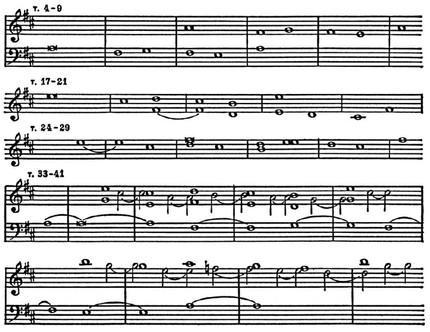
Contrapuntal Combinations in Credo (No 12) from Mass in h-moll by J. S. Bach.
the derivative in the form of a canon (number 78) is formed as a result of a horizontal shift and at the same time holding the upper voice in an increase; at the beginning of the coda (3rd measure after the number 100) a derivative in doubly movable counterpoint (the distance of entry is 1 measure, the lower voice is moved by a decima, the upper one by a quintdecima down); contrapuntal variation ends in the final coda, where modulating canonical sounds. sequence (number 219), representing a derivative connection in doubly movable counterpoint (introduction distance 2 measures, both voices in direct movement); further (the 4th bar after the number 220) the derivative connection is a canon with vertical and horizontal movement and simultaneously with a fourfold increase in the bass (accompanying and doubling voices are omitted in the example):
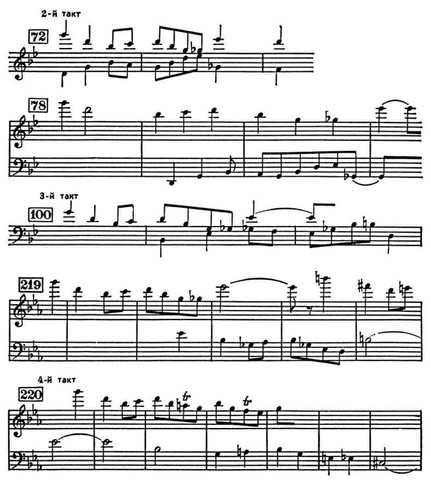
Contrapuntal combinations in the piano quintet g-moll op. 30 S. I. Taneeva.
Conclude. the canon in reverse from the b-moll fugue from the 2nd volume of J.S. Bach’s Well-Tempered Clavier is an example of an incomplete reversible counterpoint with doublings. The fifth number from Bach’s “Musical Offering” is an endless canon in circulation that accompanies this voice, where the initial connection forms an overhead. voice and simple (P), derivative in incomplete reversible horizontally movable counterpoint – in the same voice and risposta (R Compound counterpoint):

S. to. – the area most obviously associated with the rational side of creativity. process of the composer, which largely determines the corresponding imagery of the muses. speech. S. to. – the basis of shaping in polyphony, one of the most important means of polyphonic. development and variation. Its possibilities were realized and developed by masters of strict style; in subsequent periods of development of music. lawsuit and in modern. S.’s music is widely used in polyphonic. and homophonic forms.

A musical example from the version of the introduction to Taneyev’s Mobile Counterpoint of Strict Writing.
harmonic freedom of modern music allows composers to apply the most complex in technical. regarding S.’s variety to. and their combination. So, for example, in No. 23 from Shchedrin’s Polyphonic Notebook, the initial combination of both themes of the double fugue (bars 1-5) gives a set (see bars 9, 14, 19 and 22, 30, 35., 40, 45) of non-repeating derivative compounds in vertical, horizontal and doubly movable counterpoint (with doublings).
The indicated three types of S. to. S. I. Taneyev considered the main, but not the only possible ones. The published fragment from the version of the introduction to the book “Mobile counterpoint of strict writing” indicates that Taneyev included in the area of uXNUMXbuXNUMXbS. k. also that kind of it, where a derivative compound is formed as a result of the use of a rakish movement.
In his writings, S. I. Taneev did not consider either reversible (although this was part of the plans of his scientific research) or contrapoint counterpoint (as, apparently, it did not have much practical significance at that time). The theory of polyphony, taking into account the features of modern. composer’s practice, expands the concept of S. to. and considers as its independent types a rakohodny counterpoint, and also allowing an increase or decrease in a derivative compound to. from melodic votes of the original. For example, in the rondo-shaped finale of Karaev’s 3rd symphony, the initial refrain is written in the form of a 3-goal. inventions where incoming voices (rhythmically similar to the theme) are added together with counter-additions from the sounds of the dodecaphone series; The 2nd holding of the refrain (number 4) is a derivative compound in the recoil counterpoint; in the 2nd episode, written in the form of a fugue, the reprise stretta (16 measures up to the number 10) is made up of carrying out the theme in the forward and sideways movements; at the beginning of the reprise of the 1st part of the symphony (number 16), the 3rd goal sounds. endless canon, where is the top. the voice is a theme-series in the direct, the middle voice is in a slinging movement, and the lower one is in a reversed sloping movement.
Counterpoint, allowing an increase or decrease in one or several. voices, theoretically studied little.
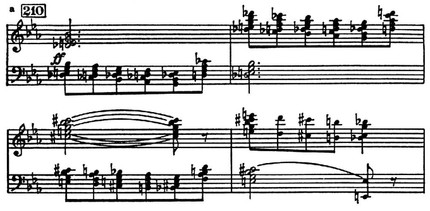
HA Rimsky-Korsakov. “The Tale of the Invisible City of Kitezh…”, act 3, scene 2.
Numerous examples from classical and modern music show that combinations with increase or decrease often arise without preliminary calculation, unintentionally (see the above example from Bach’s Credo; “Discharges” – the 2nd part of L. Grabowski’s “Little Chamber Music No. 1” – are made up of conducting a dodecaphonic theme , to which its variants are added in a 2-15-fold reduction). However, in some works, obtaining derivative combinations of this kind, obviously, was part of the composer’s original intention, which proves their fundamental belonging to the area of s. Bach; in the 1st part of Glazunov’s 1th symphony, the derivative (number 8) is based on the original compound (number 30) in incomplete reversible counterpoint with an increase in one of the voices; complex combinations with increasing theme form derivative compounds in FP. Taneyev’s g-moll quintet (numbers 31 and 78; see example in col. 220).
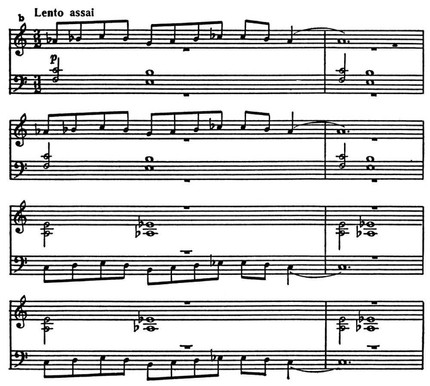
V. Tormis. “Why are they waiting for Jaan” (No 4 from the choral cycle “Songs of Jan’s Day”).
Modern the theory of polyphony makes adjustments to the interpretation of counterpoint, which allows doubling, since the harmonic. music standards of the 20th century. but limit the use of duplications to.-l. def. intervals or chords. For example, in the 2nd scene of the 3rd act of the opera “The Legend of the Invisible City of Kitezh and the Maiden Fevronia” by Rimsky-Korsakov (number 210), the imitation of the Tatars’ leitmotif is presented by parallel minds. seventh chords (see example a); in the song “Why they are waiting for Yaan” (No 4 from the chorus cycle “Songs of Yaan’s Day” by V. Tormis), the voices move in parallel fifths (“vertically moving harmony”, as defined by S. S. Grigoriev; see example b), in No 7 of the same doubling cycle have a cluster nature (see example c);
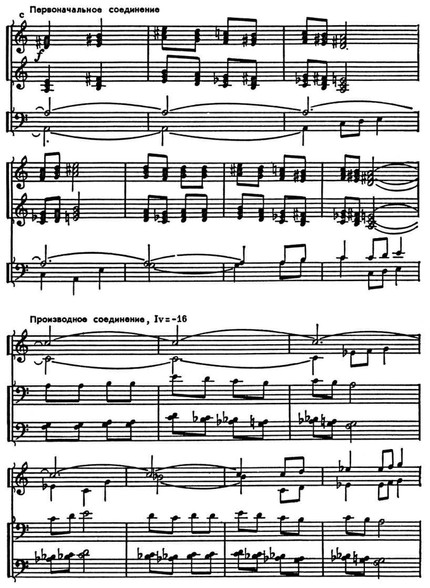
V. Tormis. “Song of Jan’s Day” (No 7 from the choral cycle “Songs of Jan’s Day”).
in “Night” from Prokofiev’s “Scythian Suite” the voices in an infinite canon-type construction are duplicated by chords of different structures (see example d, col. 99).
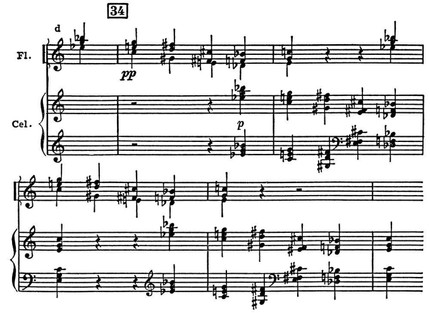
S. S. Prokofiev. “Scythian Suite”, 3rd part (“Night”).
A table of all theoretically possible combinations of types of s. to.
References: Taneev S. I., Movable counterpoint of strict writing, Leipzig, 1909, M., 1959; Taneev S. I., From the scientific and pedagogical heritage, M., 1967; Bogatyrev S. S., Reversible counterpoint, M., 1960; Korchinsky E., To the question of the theory of canonical imitation, L., 1960; Grigoriev S. S., On the melody of Rimsky-Korsakov, M., 1961; Yuzhak K., Some features of the structure of the fugue by J. S. Bach, M., 1965; Pustylnik I. Ya., Movable counterpoint and free writing, L., 1967. See also lit. under the articles Movable counterpoint, Reversible counterpoint, Rakokhodny movement.
V. P. Frayonov



